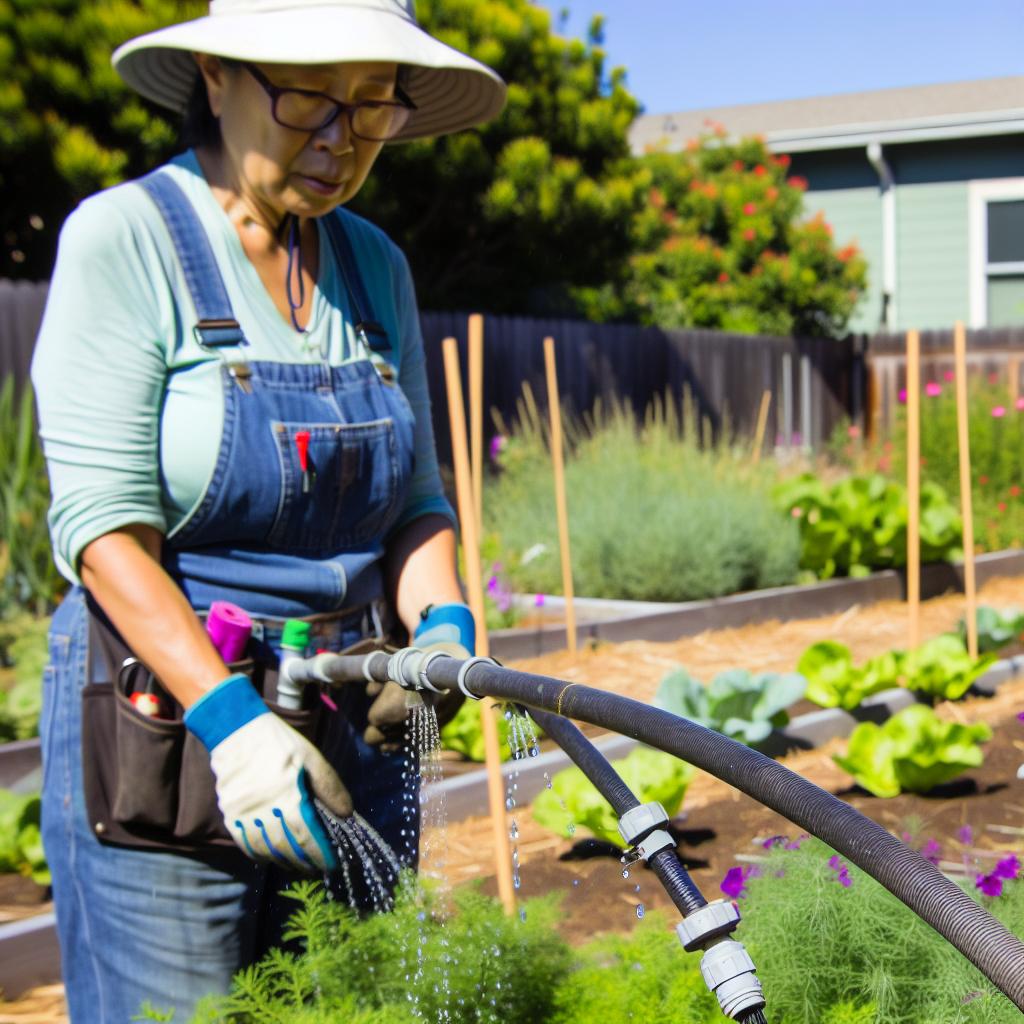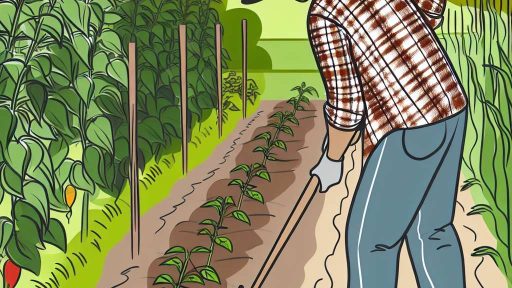Introduction to Drip Irrigation and Its Benefits for Community Gardens
What Is Drip Irrigation?
Drip irrigation delivers water directly to plant roots through a system of tubes and emitters.
This method reduces evaporation and water runoff significantly.
Gardeners can control water flow precisely with a timer or manual system.
Therefore, plants receive the exact amount of water they need to thrive.
Water Conservation Advantages
Drip irrigation conserves water by minimizing wastage during watering.
Because it targets root zones, less water is lost to evaporation and wind.
Community gardens especially benefit from these savings during hot or dry seasons.
Moreover, efficient water use lowers garden maintenance costs over time.
Enhancing Plant Health and Productivity
Consistent moisture delivery promotes healthier root development and higher yields.
Unlike overhead watering, drip irrigation reduces the risk of diseases caused by wet foliage.
Consequently, plants grow stronger with less stress from overwatering or drought.
Environmental and Community Impact
Reducing water consumption helps preserve local water resources sustainably.
Communities grow more resilient gardens that support local food security.
Additionally, drip systems encourage responsible gardening practices among members.
Thus, drip irrigation becomes a key tool for environmental stewardship in shared spaces.
Transform Your Agribusiness
Unlock your farm's potential with expert advice tailored to your needs. Get actionable steps that drive real results.
Get StartedUnderstanding Water Conservation: Importance and Impact in Gardening
Significance of Water Conservation in Gardening
Water conservation saves a vital resource used daily in gardens.
It reduces water bills for community garden members.
Effective water use supports plant health and growth sustainably.
Gardens can thrive through dry seasons and droughts.
Preserving water helps protect local ecosystems and wildlife.
Environmental Benefits of Conserving Water in Gardens
Conserving water decreases demand on municipal water supplies.
It lessens the energy used for water treatment and delivery.
Reduced water consumption limits pollution from excess runoff and erosion.
It minimizes strain on natural waterways and aquifers.
Community gardens that conserve water promote overall environmental stewardship.
Social and Economic Impact of Water Conservation
Water conservation fosters community cooperation and shared responsibility.
It helps community gardens remain affordable and accessible.
Gardeners learn efficient watering techniques and resource management skills.
Reduced water use allows more people to benefit from shared garden spaces.
Water-wise gardening supports long-term community resilience.
Components of a Drip Irrigation System
Essential Materials for Installation
A drip irrigation system requires specific materials to function effectively.
First, you need drip tubing that distributes water directly to plants.
Next, use emitters or drippers to control water flow at each plant’s base.
Additionally, a main supply hose connects your water source to the drip tubing.
Moreover, connectors and fittings join tubing sections and maintain system integrity.
Do not forget pressure regulators to keep water pressure at an optimal level.
Filters play a vital role by preventing debris from clogging the emitters.
A timer automates watering schedules, ensuring consistent water delivery.
Equipment Needed for Successful Setup
Install a backflow preventer to avoid contamination of your water supply.
Showcase Your Farming Business
Publish your professional farming services profile on our blog for a one-time fee of $200 and reach a dedicated audience of farmers and agribusiness owners.
Publish Your ProfileA punch tool helps create holes in tubing for inserting emitters smoothly.
Cutters allow you to trim tubing to fit the garden layout precisely.
Additionally, stakes secure tubing in place and keep the system stable.
A pressure gauge helps monitor water pressure for system adjustments.
Moreover, clamps may be needed to attach tubing to structures or soil.
Choosing Quality Components
Select durable materials made from UV-resistant plastic to last outdoors.
Ensure emitters provide adjustable flow rates for different plant needs.
Pick filters with fine mesh to trap small particles effectively.
Furthermore, choose timers with flexible programming options.
Consult with irrigation specialists like Greenfield Hydro Solutions for reliable products.
Discover More: Best Organic Soil Management Practices For High-Yield Community Garden Plots
Designing an Efficient Drip Irrigation Layout for Community Gardens
Assessing Garden Needs and Layout
Begin by evaluating the size and shape of the community garden.
Understand the types of plants grown and their water requirements.
Next, map out sun exposure and soil types within the garden blocks.
This information helps in planning a customized irrigation system.
Moreover, consider any existing water sources and pressure levels.
Choosing Appropriate Drip Irrigation Components
Select mainlines and sub-mainlines that suit the garden’s dimensions.
Use pressure regulators to maintain consistent water flow throughout.
Also, pick emitters based on the specific water needs of each plant.
Drip tapes and micro-sprayers work well for closely spaced beds.
Furthermore, filtration units protect the system from clogging.
Planning the Layout for Maximum Efficiency
Design drip lines parallel to plant rows to reduce water waste.
Place emitters near plant roots to deliver water directly.
Additionally, divide the system into zones for better control.
Zones allow scheduling irrigation based on plant type and sun exposure.
Include easy access points for maintenance and system checks.
Implementing Water-Saving Features
Incorporate timers or smart controllers to automate watering schedules.
Use soil moisture sensors to adapt irrigation to current soil conditions.
Mulching around plants complements drip irrigation by reducing evaporation.
Periodic system audits ensure leak-free operation and water efficiency.
Community involvement in monitoring promotes responsible water use.
Discover More: Small Livestock Management for Backyard Farming and Urban Homesteads
Implementing Drip Irrigation Step-by-Step Installation Guide
Planning Your Drip Irrigation System
Begin by assessing the specific water needs of your community garden.
Next, map out the garden layout including plant locations and spacing.
Consider the local water source and pressure to select appropriate equipment.
Choose drip irrigation components that match your garden’s size and crop types.
For guidance, consult with irrigation experts like Evergreen Waters Irrigation.
Gathering Materials and Tools
Collect essential materials such as drip tubing, emitters, connectors, and filters.
Ensure you have tools including a tubing cutter, pressure regulator, and stakes.
Purchase a timer system to automate watering schedules efficiently.
Showcase Your Farming Business
Publish your professional farming services profile on our blog for a one-time fee of $200 and reach a dedicated audience of farmers and agribusiness owners.
Publish Your ProfileUse high-quality parts from trusted suppliers like Evergreen Irrigation Supplies.
Preparing the Garden Bed
Clear debris and weeds from the planting area thoroughly.
Level the soil surface for uniform irrigation coverage.
Mark the drip lines according to the planned layout carefully.
Check that the soil is moist but not saturated before installation.
Installing the Main Supply Line
Attach the main hose to the water source securely.
Install a backflow preventer to protect the water supply from contamination.
Connect a pressure regulator to maintain appropriate water flow.
Lay the main supply line along the garden perimeter or designated route.
Laying Out Drip Tubing and Emitters
Cut drip tubing to fit along each plant row precisely.
Insert emitters or drip lines close to the plant roots for efficient watering.
Secure tubing with stakes to prevent movement and damage.
Use connectors and end caps to join and seal tubing sections properly.
Testing and Adjusting the System
Turn on the water supply to check for leaks or pressure drops.
Observe emitters closely to ensure uniform water distribution.
Adjust or replace clogged emitters quickly to maintain system performance.
Set the timer based on plant water requirements and local weather conditions.
Maintaining Your Drip Irrigation System
Regularly inspect tubing and connections for wear and tear.
Flush the system periodically to remove sediment and prevent clogging.
Adjust emitter placement as plants grow or garden layout changes.
Record watering schedules to optimize water conservation over time.
Delve into the Subject: The Role of Companion Planting in Organic Pest Management
Best Practices for Maintaining Drip Irrigation Systems
Regular Inspection and Cleaning
Regularly inspect your drip irrigation system to ensure optimal performance.
Check for clogged emitters, leaks, and damaged tubing after each use.
Flush the system periodically to remove sediment and debris from pipes.
Use filtered water to reduce the buildup of minerals and organic matter.
Replace clogged or broken emitters promptly to maintain uniform watering.
Proper System Winterization
Drain all water from the drip irrigation lines before the cold season arrives.
This prevents freezing damage and prolongs the lifespan of the tubing.
Store removable components in a dry, sheltered area during winter.
Inspect and repair parts before reinstalling the system in spring.
Monitoring Water Pressure and Timing
Use a pressure regulator to maintain consistent water flow throughout the system.
Excessive pressure can cause tubing damage and uneven watering distribution.
Set irrigation timers according to plant needs and weather conditions.
Adjust watering schedules seasonally to optimize water conservation.
Maintaining Filters and Valves
Clean or replace filters regularly to prevent clogging in the irrigation lines.
Ensure valves open and close properly to control water flow effectively.
Lubricate valve components when necessary to avoid stiffness or leaks.
Schedule routine checks to identify issues before they impact system function.
Documentation and Record-Keeping
Maintain a log of maintenance activities and any repairs performed.
Showcase Your Farming Business
Publish your professional farming services profile on our blog for a one-time fee of $200 and reach a dedicated audience of farmers and agribusiness owners.
Publish Your ProfileThis helps track system performance and identify recurring problems.
Use notes to optimize maintenance schedules and improve efficiency over time.
Encourage community garden members to report any system irregularities promptly.
Training and Community Engagement
Provide training sessions for gardeners on proper system use and care.
This ensures everyone understands how to operate and maintain the system responsibly.
Encourage shared responsibility to keep the irrigation system in good condition.
Foster a culture of water conservation through regular communication and education.
Learn More: Indoor Gardening Challenges for Maintaining a Pest-Free Environment

Common Challenges and Solutions in Drip Irrigation for Community Gardens
Clogging of Emitters
Clogging is a frequent issue in drip irrigation systems.
Particles and minerals can block the small holes in emitters.
To prevent this, install a quality filter at the water source.
Regularly flush the lines to remove accumulated debris.
Using filtered or treated water reduces the risk of clogging significantly.
Uneven Water Distribution
Uneven watering causes some plants to get too much or too little water.
This problem often results from improper system design or elevation changes.
Design the system with proper pressure regulation and layout adjustments.
Include pressure compensating emitters to maintain consistent flow rates.
Test the system thoroughly after installation and adjust to ensure balance.
Damage from Garden Activities
Garden tools and foot traffic sometimes damage drip lines accidentally.
Such damage leads to leaks and water wastage.
Clearly mark irrigation tubing and avoid running lines in high-traffic zones.
Elevate lines or bury them slightly to protect from physical harm.
Engage gardeners like Mia Carlson to handle irrigation with care.
System Maintenance and Monitoring
Neglecting regular maintenance reduces system efficiency over time.
Schedule routine inspections to identify leaks or faulty parts early.
Train volunteers such as community leader Carlos Rivera on maintenance tasks.
Record system performance and water usage to inform improvements.
Implement a simple checklist for quick daily or weekly evaluations.
High Initial Installation Costs
Upfront costs can discourage community gardens from adopting drip irrigation.
However, water savings and improved yields offset costs over time.
Seek local grants and programs supporting sustainable gardening initiatives.
Partner with companies like GreenLeaf Supplies for discounts or donations.
Start with a small pilot area and gradually expand the system as funds allow.
Case Studies of Successful Community Gardens Using Drip Irrigation
Green Haven Community Garden
Green Haven Community Garden implemented drip irrigation to address water waste.
The team installed a network of drip lines beneath soil beds for precise watering.
As a result, water usage dropped by 40% in the first year of adoption.
Additionally, vegetable yields increased due to consistent moisture delivery.
Garden coordinator Rosa Martinez praised the system’s efficiency and ease of use.
The community now enjoys fresher produce with less environmental impact.
Sunrise Urban Garden Collective
Sunrise Urban Garden Collective faced severe water restrictions in their city.
Showcase Your Farming Business
Publish your professional farming services profile on our blog for a one-time fee of $200 and reach a dedicated audience of farmers and agribusiness owners.
Publish Your ProfileConsequently, they adopted drip irrigation paired with rainwater harvesting.
The combination allowed them to maintain healthy plants during dry spells.
Moreover, volunteers reported reduced labor hours spent on manual watering.
Local resident and gardener David Kim highlighted improved plant health and growth.
This project inspired other urban gardens to explore drip irrigation technologies.
Riverside Neighborhood Garden
The Riverside Neighborhood Garden encountered challenges with uneven water distribution.
Therefore, they switched to a drip irrigation system with automated timers.
Installation led to precise watering schedules preventing overwatering and runoff.
Significantly, water conservation efforts saved thousands of gallons annually.
Garden manager Aisha Thompson emphasized the cost savings on water bills.
The garden now thrives with reduced maintenance demands and healthier plants.
Elmwood Cooperative Garden
Elmwood Cooperative Garden sought sustainable solutions to support diverse crops.
They integrated drip irrigation alongside soil moisture sensors for efficiency.
This technology helped tailor watering to specific plant needs and weather conditions.
Farmers observed stronger root systems and less fungal disease occurrence.
Elizabeth Carter, a cooperative member, praised the system’s positive impact on sustainability.
The garden became a model for resource-conscious community agriculture.
How to Educate Community Garden Members on Using Drip Irrigation Effectively
Introducing Drip Irrigation Benefits
Begin by explaining the key benefits of drip irrigation to all garden members.
Emphasize how drip systems save water and enhance plant growth.
Also, highlight the cost savings that come with efficient water use.
Use real examples from local community gardens to make the message relatable.
Organizing Informative Workshops
Arrange hands-on workshops led by irrigation expert Lucas Hernandez.
Use these sessions to demonstrate proper installation and maintenance techniques.
Encourage members to ask questions and share their experiences during the event.
Provide printed guides created by GreenSprout Solutions for future reference.
Creating User-Friendly Instructional Materials
Develop simple manuals with clear illustrations, tailored for all experience levels.
Include step-by-step instructions for troubleshooting common drip irrigation issues.
Distribute these materials both digitally and as printed copies in the garden shed.
This approach ensures accessibility for all community members.
Utilizing Peer Learning and Support
Identify experienced gardeners like Maria Kim to act as irrigation mentors.
Set up a buddy system to help new users gain confidence with the technology.
Regularly schedule informal check-ins where members can discuss challenges together.
Fostering peer support improves overall system efficiency and reduces water waste.
Encouraging Regular Monitoring and Feedback
Teach members to monitor soil moisture and drip emitter performance consistently.
Implement a feedback loop where users report observations to garden coordinators.
Use this data to adjust irrigation schedules and improve water conservation efforts.
Tools like moisture meters from AquaSense Incorporated can aid this process effectively.
Additional Resources
Drip Irrigation for Home Gardens – 4.702 – Extension
Planting More than Just Veggies: Student-Created Plans for a …




